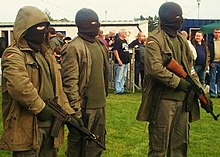Provisional Irish Republican Army

The Provisional Irish Republican Army was an Irish republican paramilitary organisation that wanted to unite Ireland, by using armed force to remove Northern Ireland from the United Kingdom, mainly during The Troubles era. It split from the Irish Republican Army (IRA) in 1969. Its violent activities formally ended in 1997. During that time, about 10,000 people were members. In 2002, there were about 1,000 people left; 300 of them were still in active service. In July 2005 it destroyed all its weapons and bombs.[source?]
Its opponents were the British Army, the Royal Ulster Constabulary, and loyalist paramilitary groups like the Ulster Volunteers. The PIRA aimed to remove Northern Ireland from the United Kingdom and create a socialist republic within a united Ireland. It tried to do this through armed attacks and explosions and by using political persuasion.
The Provisional Irish Republican Army is also referred to as the IRA, the PIRA, the Provos, or by its supporters as the Army or the 'RA. The PIRA usually refers to its members as volunteers. The IRA is a listed in the UK under the Terrorism Act 2000. It is also listed as an unlawful organisation in the Republic of Ireland. The United States does not list the IRA as a "foreign terrorist organization", but includes them in the category of "other selected terrorist groups also deemed of relevance in the global war on terrorism.".
Overview of strategies
[change | change source]The IRA's first strategy was to use force to destroy the Northern Ireland administration and to hurt or kill enough British soldiers and police officers that the British government would leave.[1] The IRA recruited volunteers. They got more volunteers after the 1972 Bloody Sunday attack, in which the British military fired on protesters. The IRA then attacked against British military and economic targets.[2][3] They were supported by arms and funding from Libya,[4] revolutionary movements in Europe, and from some groups in the Republic of Ireland, the United States, Canada, Australia and New Zealand.[5][6][7]
The IRA agreed to a ceasefire in February 1975, which lasted nearly a year. Then the IRA decided it could not meet its goals with the ceasefire.[8] As a result, the IRA launched a new strategy known as "the Long War". This started a war of attrition against the British. As well, they did more political activity through the political party Sinn Féin.[9]
The 1981 Irish hunger strike helped the IRA to gain support and win elections. This led to the Armalite and ballot box strategy which aimed at doing more political activity. The unsuccessful attempt to do more military attacks led republican leaders to look for a political solution. Sinn Féin got more distanced from the IRA. Following negotiations with the Social Democratic and Labour Party (SDLP) and with British civil servants, the IRA called a ceasefire in 1994. They expected that Sinn Féin would be included in political talks for solving the disputes.[10] When the British government demanded the disarmament of the IRA before it allowed Sinn Féin into talks, the IRA called off its ceasefire in February 1996.
After the ceasefire was reinstated in July 1997, Sinn Féin was admitted into all-party talks. This produced the Good Friday Agreement of 1998. The IRA's armed campaign, primarily in Northern Ireland but also in England and mainland Europe, caused the deaths of approximately 1,800 people. The dead included around 1,100 members of the British security forces, and about 640 civilians.[11][12] The IRA itself lost 275–300 members,[13] of an estimated 10,000 total over the 30-year period.
On 28 July 2005, the IRA Army Council announced an end to its armed campaign. The IRA stated that it would use only political and democratic processes.[14] Soon after, the IRA destroyed its guns and bombs.
Two small groups split from the Provisional IRA, the Continuity IRA in 1986, and the Real IRA in 1997. Both reject the Good Friday Agreement and continue to engage in paramilitary activity.
References
[change | change source]- ↑ O'Brien The Long War, p. 119.
- ↑ O'Brien, Long War, p. 107.
- ↑ The Prevention of Terrorism in British Law by Clive Walker (ISBN 978-0719022036), page 9
- ↑ Bowyer Bell, J. (1997). The Secret Army: The IRA. Transaction Publishers, pp. 556–571. ISBN 1-56000-901-2
- ↑ John O'Sullivan (15 February 2005). "The Padre Pio". National Review. Archived from the original on 14 August 2007. Retrieved 21 April 2007.
- ↑ John Lloyd (28 October 2002). "Sinn Féin could win the peace". New Statesman. UK. Archived from the original on 27 September 2007. Retrieved 21 April 2007.
- ↑ Gearóid Ó Faoleán (23 April 2019). A Broad Church: The Provisional IRA in the Republic of Ireland, 1969–1980. Merrion Press. p. 78 and 101. ISBN 1-7853-7245-9.
{{cite book}}: CS1 maint: year (link) - ↑ Taylor, Peter (2001). Brits. Bloomsbury Publishing. pp. 184–185. ISBN 0-7475-5806-X.
- ↑ The Irish Troubles: A Generation of Violence 1967–1992 by John Bowyer Bell (ISBN 0-7171-2201-8), page 555
- ↑ Tonge, Johnathan (1996). Northern Ireland: Conflict and Change. Longman. p. 168. ISBN 978-0-582-42400-5.
- ↑ 1969–2001: 1,821 deaths, including 621 civilians. Source: 2002 online update of 1994 book — Malcolm Sutton (1994) Bear in mind these dead ... An Index of Deaths from the Conflict in Ireland 1969–1993, Belfast: Beyond the Pale Publications, ISBN 0-9514229-4-4. Update hosted at CAIN research project at the University of Ulster, CAIN: Sutton Index of Deaths – extracts from Sutton's book Archived 2006-07-09 at the Wayback Machine
- ↑ 1969–2004: 1,781 deaths, including 644 civilians. Source: Lost Lives: The Stories of the Men, Women and Children Who Died Through the Northern Ireland Troubles (2004. Ed's David McKitrick, Seamus Kelters, Brian Feeney, Chris Thornton, David McVea), Mainstream Publishing, ISBN 978-1-84018-504-1, page 1536
- ↑ Lost Lives (2004), p1531 – 294 members; Sutton (2002) – 276 members.
- ↑ "Full text: IRA statement". The Guardian. London. 28 July 2005. Retrieved 17 March 2007.
